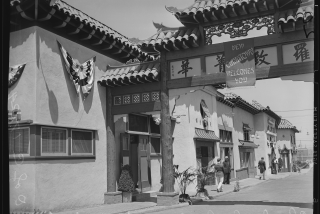The startling spirit of Malacca, Malaysia
Reporting from Malacca, Malaysia — What traveler hasn’t landed in a dreamed-of destination and found it crawling with tourists, fast-food franchises, name-brand stores and dollar-a-beer bars? The good bones of Charleston, S.C., which made the World Monuments Fund’s list of imperiled cultural sites this year because of cruise ship congestion, may be intact, but when commercial tourism runs amok you’ve got yourself a tourist trap.
Since 1972, the UNESCO World Heritage program has kept its own list, now 936 properties strong, of cultural and natural sites important to mankind, most of them in some way endangered or underdeveloped. But along with focusing attention and support on listed properties, inscription spurs visitation, with ill-conceived tourist development often in its path.
I found a case in point last year: Malacca, inscribed with its sister city George Town on the west coast of peninsular Malaysia, by UNESCO in July 2008. Founded by a Hindu prince who traveled on an elephant and converted to Islam in 1409, the Malacca Sultanate became the crossroads of Asia, passing from hand to hand like a magic lamp.
In 1511, a fleet of Portuguese swashbucklers defeated the sultan to corner the spice trade. Then Dutch East India Co. merchants right out of a Vermeer painting stole it from the Portuguese, governing from a stadhuis, or town hall, that still looks as stalwart as any on the continent.
The English who followed developed Singapore at the former sultanate’s expense, almost tearing down A’Famosa, a Portuguese-era gate thought to be the oldest vestige of colonial Europe in Asia.
Malaysia declared independence from Britain in 1957, hoisting its flag from A’Famosa, but after that Kuala Lumpur became the nation’s capital and the cavalcade passed by. When the dust settled, the old crossroads of Asia was a curio.
To me it seemed the most exotic place on Earth, so I made it my first stop last fall on a month-long trip to Southeast Asia.
I realize now that I was expecting the Charlie Chan movie version of Malacca, with opium dens, purloined objets d’art, veiled concubines and spy rings. What I found was the Colonial Williamsburg of Southeast Asia, mobbed by weekenders from Singapore and Kuala Lumpur come to snap pictures under A’Famosa, not to be confused with A’Famosa Water World Resort just outside of town.
If I hadn’t been so surprised by Malacca’s latest incarnation, I’d have been disappointed. But having my expectations confounded is part of the reason I travel. And they were from the moment I landed in Kuala Lumpur and caught a cab to Malacca for about $60 — an eye-opening ride down the superhighway that links KL, as Kuala Lumpur is called, to Singapore, just beyond the tip of the peninsula, in less than 200 miles.
When we reached Malacca the taxi deposited me at the Hotel Puri on Jalan Tun Tan Cheng Lock, also known as Heeren Street for the Dutch settlers who lined it with snug, gabled row houses, and then Millionaires Row when it became the envied abode of rich Strait-born Chinese — progeny of Chinese immigrants to the region — who decorated the façades with lanterns and traditional see-through tile windows. Made up of several conjoined residences, the Puri has modern air-conditioned rooms above a courtyard restaurant, a heliconia garden and a fish pond. Endearing little swifts squeaked from cool, dark cubbyholes around the rafters where they built nests made of their saliva, a Chinese soup delicacy commercially produced in abandoned houses around town.
In the steamy heat I studied a map, turning it one way and then another, unable to get my bearings. I knew that the town grew up along a lazy, winding river that drains into the ocean. But no matter where I looked, I couldn’t see the Strait of Malacca.
So I set off to find it, walking through deserted weekday afternoon streets until I ran into the river. The old bridge that crosses it leads to the Dutch town square and St. Paul’s Hill, surrounded by a massive fort built in the Portuguese era. But I obstinately turned away from these landmarks and kept following the river west. I must have walked for almost an hour before realizing that the wide flatland I was crossing was reclaimed from the sea, meaning that historic Malacca is no longer on the Strait of Malacca.
Along with coastal reconfiguration, high-rise hotels, housing developments, a revolving tower, food courts and shopping malls have transformed the cityscape. In 2000 Jonker Walk, a weekend street fair in the architecturally sensitive commercial district north of the river known as Chinatown, was added to the town’s tourist attractions, drawing crowds of partyers from the big urban centers of KL and Singapore.
In “Malacca: Voices From the Street,” coauthors Lim Huck Chin and Fernando Jorge report that the fair has displaced traditional family businesses — Indian gold traders, Chinese blacksmiths, Portuguese-Malay fishermen and others who made the neighborhood singular — priced-out of atmospheric shop houses by look-alike tourist hotels and fast-food restaurants. When each one goes, it takes a piece of fabled Malacca with it.
Wilted, I stood on a concrete embankment where the walkway finally ended at the strait and some boys were fishing. From there I could see a highway bridge under construction and the Eye on Malaysia, a Ferris wheel across the river, long closed for repair (and later dismantled), as if stilled in mid-rotation by some stalled monsoon, which is how I felt.
But on the way back to the center of town a group of Islamic schoolchildren lifted my spirits, girls in pretty pink and blue head scarves, boys in white shirts with lopsided ties. They knew just enough English to chime “Hi Auntie” to me and were giddy with excitement over the prospect of a cruise up the river. So I bought a ticket and joined them, passing the old Dutch square on my right and the packed shop houses of Chinatown on the left.
We stopped briefly in front of St. Francis Xavier Church, dedicated to a 16th century Jesuit missionary who spread Catholicism across Asia, then kept snaking up the mangrove-fringed river.
When we reached Kampung Mortem, a traditional Malay village in the middle of modern Malacca, with sloping zinc roofs, louvered windows and verandas, the boardwalks alongside the river called to me. As I prepared to disembark, an Australian woman on the boat told me to be careful because there could be crocodiles in the deep, open gutters alongside.
I kept hoping to see one over the next few days, as I toured a replica of the third sultan Mansur Shah’s palace, built in 1986 of ironwood from Sarawak using dove-tailed joints instead of nails; the roofless ruins of St. Paul’s Church, originally a Portuguese chapel dating from 1521; and, of course, A’Famosa, framed by tall palm trees and old canons.
The Dutch town square is on the river side of St. Paul’s Hill, with a marble fountain commemorating the diamond jubilee of England’s Queen Victoria, a 60-foot clock tower built by Strait-born Chinese tycoon Tan Jiak Kim, prettily clipped topiary and decorated rickshaws with portable sound systems.
Holding place of pride on the square are the ocher-colored Stadhuis, a city history museum displaying Portuguese muskets and Dutch East India Co. pewter, and Christ Church, Anglican now, but Dutch Reformed when it was completed in 1753. Tomb slabs inside bear evocative inscriptions such as: “Beneath this stone is interred with her stillborn infant the mortal remains of Mary Betty who departed this life Sept. 20, 1800, aged 30 years.”
I especially liked to roam in the old shop-house quarter near my hotel, rummaging through Jonker Street junk stores, antique jewelry shops, ground-floor garment factories and pineapple tart bakeries. During Jonker Walk weekends the district’s main street becomes a pedestrian-only night market with jugglers, food stalls and a carny air.
But on a torpid weekday you can still feel how the old neighborhood perseveres; pray in peace at a Chinese Buddhist shrine, mosque or Hindu temple; or find yourself alone at 8 Heeren St., a landmark Dutch shop house that was stunningly restored by Badan Warisan, a not-for-profit Malaysian conservation organization. It has lime-plastered brick walls, masterful carpentry and a wide front window that allowed business to be conducted on the ground floor.
A few doors down Heeren Street I found another wonderful historic building, home of the Baba Nyonya Heritage Museum. The mansion, constructed in 1896 by a rich Strait Chinese family, has 25-foot ceilings, Rococo plasterwork, mother-of-pearl-topped tables and Venetian mirrors, reflecting the taste of clan patriarchs and matriarchs known as babas and nyonyas. They sent their sons to schools in England, played polo, drank cognac and drove Rolls-Royces.
After my visit, I was sitting at Café 1511 next door, drinking a cup of strong, rich Malaysian coffee, thinking about the Malacca that is no more.
Just then a bow-legged nyonya in pedal-pushers and backless silk slippers came picking her way along Heeren Street, a spry old spirit still afoot.
More to Read
Sign up for The Wild
We’ll help you find the best places to hike, bike and run, as well as the perfect silent spots for meditation and yoga.
You may occasionally receive promotional content from the Los Angeles Times.






